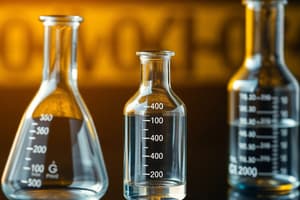Podcast
Questions and Answers
What is the primary difference between direct and indirect measurement?
What is the primary difference between direct and indirect measurement?
- Direct measurement uses a ruler, while indirect measurement uses a calculator.
- Direct measurement requires calculations, whereas indirect measurement does not.
- Direct measurement involves instruments to measure a quantity, while indirect measurement relies on calculations. (correct)
- Direct measurement can only be done in laboratories; indirect can be done anywhere.
Which of the following is a measure of accuracy in measurements?
Which of the following is a measure of accuracy in measurements?
- The variability in multiple measurements.
- The type of tool used for measuring.
- The closeness of the measurements to each other.
- The closeness of a measured value to the true value. (correct)
Which of the following tools is not used for measuring length?
Which of the following tools is not used for measuring length?
- Vernier Caliper
- Ruler
- Micrometer
- Weighing Scale (correct)
What is the SI unit for temperature?
What is the SI unit for temperature?
What defines systematic errors in measurements?
What defines systematic errors in measurements?
Why is it essential to understand metric and imperial conversions?
Why is it essential to understand metric and imperial conversions?
Which of the following statements best describes precision?
Which of the following statements best describes precision?
Which organization is known for establishing standards of measurement?
Which organization is known for establishing standards of measurement?
Flashcards are hidden until you start studying
Study Notes
Definition of Measurement
- Measurement is the process of determining the size, length, quantity, or degree of something by comparison with a standard unit.
Types of Measurement
-
Direct Measurement
- Involves measuring a quantity directly using instruments (e.g., ruler, thermometer).
-
Indirect Measurement
- Requires calculation based on other known measurements (e.g., using the Pythagorean theorem).
Units of Measurement
-
SI Units (International System of Units)
- Length: Meter (m)
- Mass: Kilogram (kg)
- Time: Second (s)
- Temperature: Kelvin (K)
- Electric Current: Ampere (A)
-
Common Non-SI Units
- Length: Inch, Foot, Mile
- Mass: Pound, Ounce
- Temperature: Celsius (°C), Fahrenheit (°F)
Measurement Tools
- Ruler, Vernier Caliper, Micrometer (for length)
- Weighing Scale (for mass)
- Stopwatch (for time)
- Thermometer (for temperature)
- Multimeter (for electric current)
Importance of Measurement
- Enables comparison and categorization of objects or phenomena.
- Essential in scientific research, engineering, construction, and daily life.
Accuracy and Precision
- Accuracy: Closeness of a measured value to the true value.
- Precision: Consistency of repeated measurements, regardless of accuracy.
Sources of Error
- Systematic Errors: Consistent, repeatable errors (e.g., faulty equipment).
- Random Errors: Variability in measurements due to unpredictable factors.
Measurement in Science
- Fundamental for experiments and data collection.
- Often requires calibration of instruments for reliable results.
Conversions
- Familiarity with metric and imperial conversions is crucial for accurate communication of measurements.
- Common conversion factors (e.g., 1 inch = 2.54 cm, 1 kg = 2.205 lbs).
Standards of Measurement
- Established by national and international organizations (e.g., NIST in the USA).
- Ensure consistency and accuracy in measurements across different regions and fields.
Definition of Measurement
- Measurement determines the size, length, quantity, or degree of an object by comparing it to a standard unit.
Types of Measurement
- Direct Measurement: Utilizes instruments for immediate measurement (e.g., rulers, thermometers).
- Indirect Measurement: Involves calculations from known values (e.g., using the Pythagorean theorem).
Units of Measurement
-
SI Units (International System of Units) include:
- Length: Meter (m)
- Mass: Kilogram (kg)
- Time: Second (s)
- Temperature: Kelvin (K)
- Electric Current: Ampere (A)
-
Common Non-SI Units:
- Length: Inch, Foot, Mile
- Mass: Pound, Ounce
- Temperature: Celsius (°C), Fahrenheit (°F)
Measurement Tools
- Common tools include:
- Ruler for length
- Vernier Caliper and Micrometer for precise measurement of length
- Weighing Scale for mass
- Stopwatch for time
- Thermometer for temperature
- Multimeter for electric current measurement
Importance of Measurement
- Essential for comparison, categorization, and validation across scientific research, engineering, construction, and everyday tasks.
Accuracy and Precision
- Accuracy refers to how close a measured value is to the true value.
- Precision indicates the consistency of repeated measurements, not necessarily how close they are to the true value.
Sources of Error
- Systematic Errors: Occur consistently due to faulty equipment or environmental conditions.
- Random Errors: Arise from unpredictable factors leading to variability in measurements.
Measurement in Science
- Integral to conducting experiments and collecting data, requiring calibration for accurate and reliable results.
Conversions
- Understanding metric and imperial conversions is vital for effective communication of measurements.
- Common conversions include:
- 1 inch = 2.54 cm
- 1 kg = 2.205 lbs
Standards of Measurement
- Established by national and international organizations (e.g., NIST) to ensure consistency and accuracy across various regions and fields.
Studying That Suits You
Use AI to generate personalized quizzes and flashcards to suit your learning preferences.




